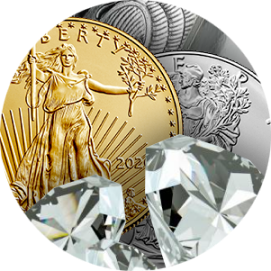Alloy The mixture of two or more metals, usually for purposes of strengthening the one which is the dominant part of the alloy. Gold is frequently alloyed with copper.
Ask The price that a seller is willing to take in order to effect the sale.
Assay Analytic test or trial to ascertain the fineness and weight of a precious metal.
Au Chemical symbol for gold.
Bag marks Minor abrasions on an otherwise uncirculated coin, caused by contact between coins in a mint bag.
Bid The price offered to buy a particular precious metal item.
Bullion Precious metal in negotiable or tradable form, such as a wafer or bar.
Bullion coin A coin that is purchased at a price close to its intrinsic or precious metal value. (Examples: U.S. Eagles and Canadian Maple Leafs.)
Business strike A coin which has been struck for circulation.
Coin A piece of metal intended for use as legal tender and stamped with marks or inscriptions which show that it was issued by an authority that guarantees its weight and purity most often a government or bank.
COMEX The Commodity Exchange, Inc. in New York, where gold and silver, as well as other commodities, are traded on a daily basis.
Counterfeit A reproduction of a coin by someone other than the government legally authorized to do so.
Deliverable bar A precious metal (gold and silver, for example) with a weight that is approved as a tradable unit on one or more of the commodity exchanges.
Depository A facility where things can be deposited for storage.
Derivative Derivatives involve the trading of rights or obligations based on the underlying product, but do not directly transfer property. They are used to hedge risk or to exchange a floating rate of return for fixed rate of return. Derivatives include futures, options, and swaps.
EFP (Exchange for Physical) A transaction in which the buyer of a cash commodity transfers to the seller a corresponding amount of long futures contracts, or receives from the seller a corresponding amount of short futures, at a price difference mutually agreed upon. In this way, the opposite hedges in futures of both parties are closed out simultaneously.
ETF (Exchange Traded Fund) An ETF is a security that tracks an index and represents a basket of stocks like an index fund, but trades like a stock on an exchange, with daily price fluctuations.
Face value The monetary worth of a coin. This does not necessarily correspond to its actual worth. For example, the 1 oz. Gold Eagle has a face value of $50 but its real value is tied to the price of gold.
Field The open area on a coin its background.
Fineness or Fine The portion of a precious metal relative to base or other alloy in a precious metal. The U.S. gold Eagle coins are .900 fine, meaning that 90% of the coin is gold and the rest alloy. British Sovereigns are .916 fine, meaning that 91.6% of the coin is gold and the rest alloy.
Fine weight The actual weight of the pure gold in a coin, ingot or bar, as opposed to the item’s total (gross) weight, which includes the weight of the alloying metal(s). Example: a 1 ounce U.S. Eagle has a fine gold weight of 31.1033 grams and a gross weight of 33.933 grams.
Futures Contract There are two types of futures contracts, those that provide for physical delivery of a particular commodity and those that call for an eventual cash settlement. The commodity itself is specifically defined, as is the month when delivery or settlement is to occur. It should be noted that very few futures contracts actually result in delivery.
Globex market Globex is the after-hours electronic trading network developed by the Chicago Mercantile Exchange. The e-mini S&P futures are one of the many contracts traded on the network
Gram The basic unit of weight in the metric system (31.1033grams =1 troy ounce).
Hallmark Mark or marks which indicate the producer of a gold bar and its fineness or other characteristics.
Intrinsic value The actual value of the precious metal within a coin.
Legend The inscription on a numismatic item.
Lettered edge Intaglio lettering milled onto the edge of a coin before striking or raised lettering on the edge of a coin produced by the use of a segmented collar die at the time of striking.
Limit (Up or Down) The maximum price advance or decline from the previous day’s settlement price permitted during one trading session, as fixed by the rules of an exchange.
London fix Price each day in London. Five old-line firms meet to set the price of gold. This is called the “fix” and is a bench mark for market trading each day.
Market value The price a coin will fetch in the open market which may be greater than or equal to its intrinsic value.
Medallion A gold wafer in round form, resembling a coin. It is not legal tender and should not be confused with genuine “coin of the realm” of a specific government.
Mint luster The sheen or bloom on the surface of an uncirculated numismatic coin resulting from the centrifugal flow of metal caused by the striking of the dies. Mint luster is somewhat frosty in appearance as opposed to the mirror-like smoothness on the field of a proof.
Mint marks A letter, symbol, or hallmark found on a coin that indicates the minting facility where it was struck. In the U.S., P (Philadelphia), D (Denver), S (San Francisco), and W (West Point) are frequently used for current coinage manufactured at those sites.
Modern issues Coins struck for current issue, either for collectors, investors or circulation.
New York close Because of the time differences, the New York gold market continues to sell precious metals for several hours after the London market has closed for the business day. Its last price has this name, and it may be higher or lower than the London fix depending upon market fluctuations.
Our Customers Keep Returning
They understand the value we offer. Our Reviews are proof.
How to Buy Hard Assets
How to Buy
Hard Assets
Receive your order in as little as 3 days.

Contact Us
Call or complete our inquiry form

Select Your Pieces
We’ll guide you through the process

Take Delivery
Postage and insurance included


